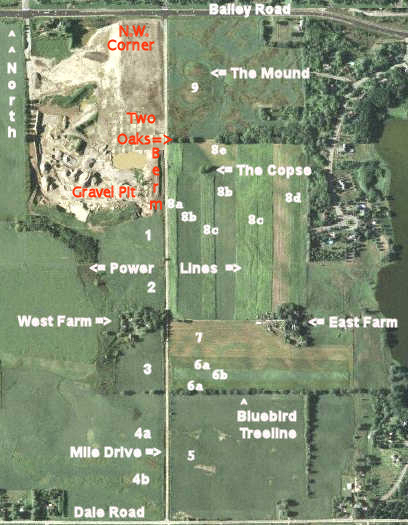
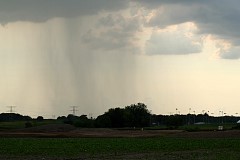 Too late to help the crops, here is one of the few showers the road received this summer.
Too late to help the crops, here is one of the few showers the road received this summer.
|
|
|
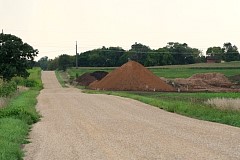
The front pile is lighter brown and has lots of sand in it. The rear pile is darker in
color showing much better soil for crops.
|
|
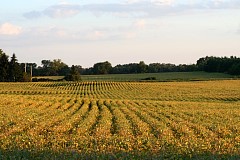
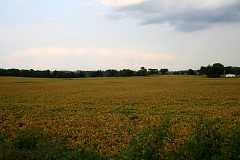
The soybeans in Field #5 has begun to turn brown.
The seed filling period and, therefore, the time to harvest maturity is depends on the amount of
daylight. The
rate of development in plants is generally slower under cool temperatures and faster under warm
temperatures, resulting in either longer or shorter duration of growing phases, respectively.
With soybeans, all of a sudden in September like this they go from green to brown.
|
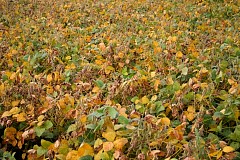
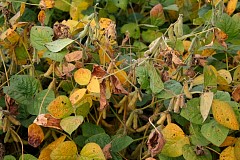
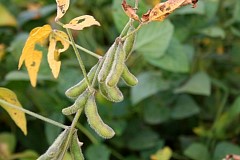 The seed filling period (SFP) is a critical period of the soybean life cycle for yield. The SFP
is distinguished by the shift in plant energy demand from primarily roots and new leaves to the seeds.
It's been a stressful year, so there aren't as many pods, seeds per pod, and the seeds
themselves are smaller.
Return to Consumables
The seed filling period (SFP) is a critical period of the soybean life cycle for yield. The SFP
is distinguished by the shift in plant energy demand from primarily roots and new leaves to the seeds.
It's been a stressful year, so there aren't as many pods, seeds per pod, and the seeds
themselves are smaller.
Return to Consumables
|
|
Healthy soybean plants will average about 2.5 seeds per
pod. For soybeans
under stress, the seeds per pod could drop to 2, 1.5, or even
less under high stress situations.
|
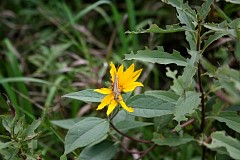
Look at how this grasshopper has demolished this Jerusalem artichoke plant, eating not only leaves but
the bloom as well.
|
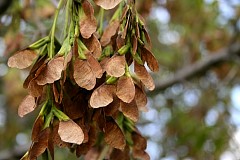
Helicopters (also called Whirlybirds) include seeds or one-seeded fruits
(samaras) with a rigid or membranous wing at one end. The wing typically
has a slight pitch (like a propeller or fan blade), causing the seed to
spin as it falls. Depending on the wind velocity and distance above the
ground, helicopter seeds can be carried considerable distances away from
the parent plant. The spinning action is similar to auto-rotation in
helicopters, when a helicopter slowly descends after a power loss.
Box Elder (Acer negundo) is a species of maple native to North America. Box Elder,
Boxelder Maple,
and Maple Ash are its most common names in the United States. Other variant names --
some of which are obviously regional -- include Ash Maple, Ash-leaf Maple, Black Ash,
California Boxelder, Cutleaf Maple, Cut-leaved Maple, Negundo Maple, Red River Maple,
Stinking Ash, Sugar Ash, Three-leaved Maple, and Western Boxelder. In Canada it is
known as Manitoba Maple. In Russia it is called American Maple.
|
|
|
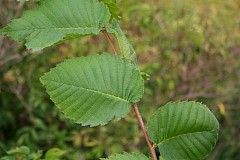
This small sapling is an American Elm - you can tell by the distinctive saw tooth edges and
the shape of the leaves. The small dead trees in the ditch near Bluebird Treeline are
elm - dutch elm disease has almost wiped out the elm.
|
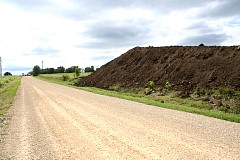
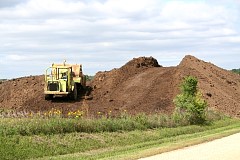 A new berm has been thrown up, but I don't believe it will be here for years as the old one was.
A new berm has been thrown up, but I don't believe it will be here for years as the old one was.
|
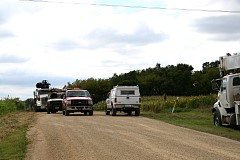
The north high
voltage power line is 115 kilovolts, while the larger south line is 345 kilovolts. The crew told
me they were contractors who get paid to travel around and fix the lines. A plane follows
the power lines and somehow determines which towers need to be replaced. For some reason the
east-most tower
on the 115 kV line needs replacement. More later ...
|
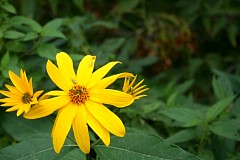
Jerusalem artichoke grows wild in North America from Saskatchewan, east to
Ontario and south to Arkansas, Georgia and Tennessee. Its original distribution
is not clear because it was widely spread by Native Americans who cultivated it
for the edible tubers. The original range probably was the northern Great Plains
of Canada and the U.S. Jerusalem artichoke grows in moist soils in old fields,
along roads and the edges of forests.
The edible tubers produced by Jerusalem artichokes are delicious and nutritious.
The tubers can be harvested anytime starting about two weeks after the flowers
have faded. Expect 2-5 pounds of tubers per plant.
They must be brushed and scrubbed under running water to remove the sand and dirt
that hides among the knobs and folds, but they do not need to be peeled. Raw Jerusalem
artichokes have a sweet nutty taste which has been likened to Brazil nuts. They are
especially good grated into fresh salads, and are a perfect snack for dieters.
Boiled and mashed they are rather similar to potatoes, and can be used like potatoes in most recipes.
|
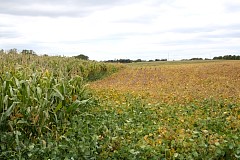
Here is the border between the corn in Field #4 and the soybeans in Field #4. Of course,
the soybeans will be harvested first since they stopped growing and will dry out first.
|
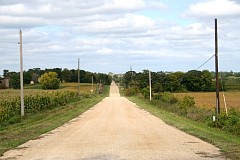
View looking north from the south end of Mile Drive.
|